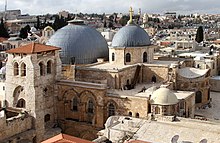| Church of the Holy Sepulchre | |
|---|---|
 The church in 2010, from left to right: the bell tower (12th century), rotunda (big dome), catholicon (smaller dome), and ambulatory | |
 | |
| 31°46′42″N 35°13′47″E / 31.77833°N 35.22972°E | |
| Location | Christian Quarter, Old City of Jerusalem |
| Denomination | Catholic, Eastern Orthodox, Armenian Apostolic |
| Website | |
| History | |
| Status | Active |
| Founder(s) | Constantine the Great |
| Consecrated | 13 September 335 (1689 years ago) |
| Architecture | |
| Architect(s) | Nikolaos Ch. Komnenos (1810 restoration) |
| Style | Paleochristian, Romanesque, Baroque |
| Groundbreaking | c. AD 326 |
| Completed | AD 335 (demolished in 1009, rebuilt in 1048) |
| Specifications | |
| Capacity | 8,000 |
| Number of domes | 3 |
| Materials | Stone |
| Part of a series on |
| Jerusalem |
|---|
 |
The Church of the Holy Sepulchre,[a][b] also known as the Church of the Resurrection,[c] is a fourth-century church in the Christian Quarter of the Old City of Jerusalem. The church is also the seat of the Greek Orthodox Patriarchate of Jerusalem.[1] Some consider it the holiest site in Christianity and it has been an important pilgrimage site for Christians since the fourth century.
According to traditions dating to the fourth century, the church contains both the site where Jesus was crucified[2] at Calvary, or Golgotha, and the location of Jesus's empty tomb, where he was buried and resurrected. Both locations are considered immensely holy sites by Christians.[3] In earlier times, the site was used as a Jewish burial ground, upon which a pagan temple was built. The church and rotunda was built under Constantine in the 4th century and destroyed by al-Hakim in 1009. Al-Hakim's son allowed Emperor Constantine IX Monomachos to reconstruct the church, which was completed in 1048. After it was captured by the Crusaders in 1099, it continued to undergo modifications, resulting in a significant departure from the original structure.[4] Several renovations and restorations were made under the Ottomans.[5] The tomb itself is enclosed by a 19th-century shrine called the Aedicule.
Within the church proper are the last four stations of the Cross of the Via Dolorosa, representing the final episodes of the Passion of Jesus. The church has been a major Christian pilgrimage destination since its creation in the fourth century, as the traditional site of the resurrection of Christ, thus its original Greek name, Church of the Anastasis ('Resurrection').
The Status Quo, an understanding between religious communities dating to 1757, applies to the site.[6][7] Control of the church itself is shared among several Christian denominations and secular entities in complicated arrangements essentially unchanged for over 160 years, and some for much longer. The main denominations sharing property over parts of the church are the Roman Catholic, Greek Orthodox, Armenian Apostolic, Coptic, Syriac, and Ethiopian Orthodox churches.
Cite error: There are <ref group=lower-alpha> tags or {{efn}} templates on this page, but the references will not show without a {{reflist|group=lower-alpha}} template or {{notelist}} template (see the help page).
- ^ "Complete compendium of Church of the Holy Sepulchre". Madain Project. Archived from the original on 29 April 2021. Retrieved 18 March 2018.
- ^ McMahon, Arthur L. (1913). "Holy Sepulchre". In Herbermann, Charles (ed.). Catholic Encyclopedia. New York: Robert Appleton Company.
- ^ "Church of the Holy Sepulchre, Jerusalem". Sacred-destinations.com. Jerusalem. 21 February 2010. Archived from the original on 3 September 2009. Retrieved 7 July 2012.
- ^ Gates, Charles (2011). Ancient cities: the archaeology of urban life in the ancient Near East and Egypt, Greece and Rome (2nd ed.). London: Routledge. p. 424. ISBN 978-0-203-83057-4.
- ^ Cite error: The named reference
Murphy56was invoked but never defined (see the help page). - ^ United Nations Conciliation Commission (1949). United Nations Conciliation Commission for Palestine Working Paper on the Holy Places. Archived from the original on 8 March 2021. Retrieved 6 July 2017.
- ^ Cust, L. G. A. (1929). . H.M.S.O. for the High Commissioner of the Government of Palestine.